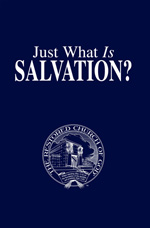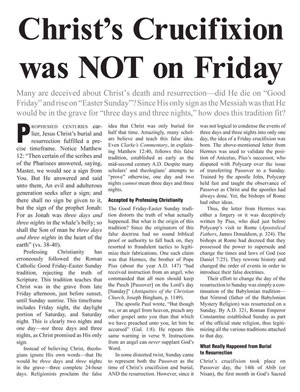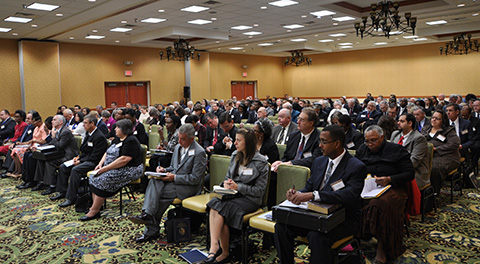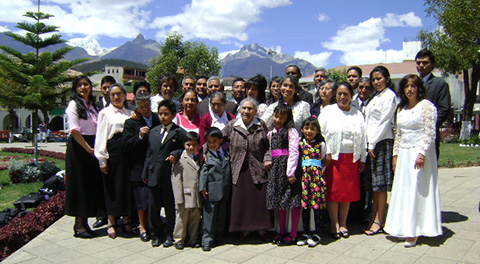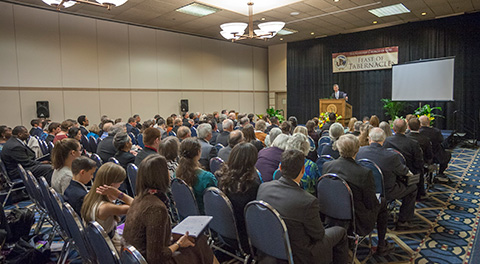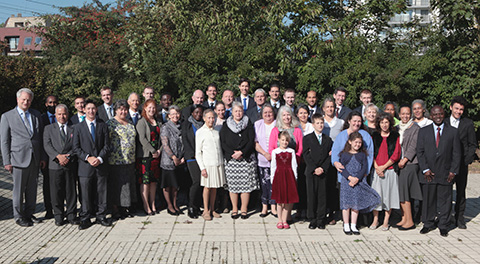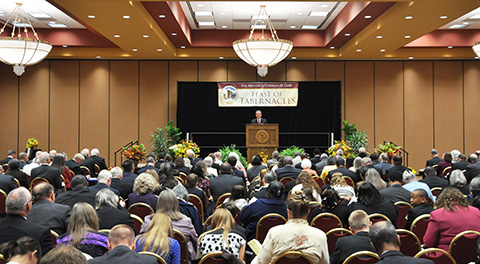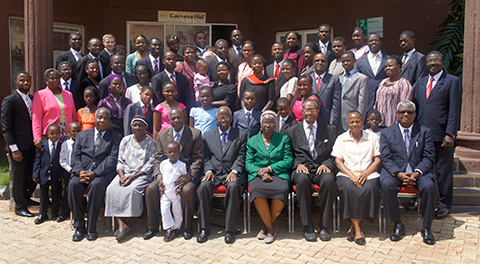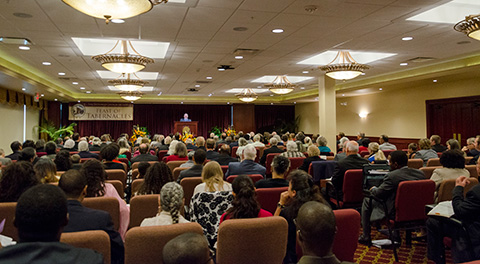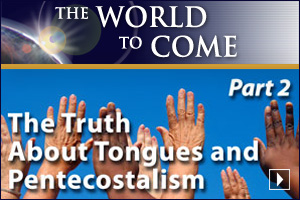Prophesied centuries earlier, Jesus Christ’s burial and resurrection fulfilled a precise timeframe. Notice Matthew 12: “Then certain of the scribes and of the Pharisees answered, saying, Master, we would see a sign from You. But He answered and said unto them, An evil and adulterous generation seeks after a sign; and there shall no sign be given to it, but the sign of the prophet Jonah: For as Jonah was three days and three nights in the whale’s belly; so shall the Son of man be three days and three nights in the heart of the earth” (vs. 38-40).
Professing Christianity has erroneously followed the Roman Catholic Good Friday-Easter Sunday tradition, rejecting the truth of Scripture. This tradition teaches that Christ was in the grave from late Friday afternoon, just before sunset, until Sunday sunrise. This timeframe includes Friday night, the daylight portion of Saturday, and Saturday night. This is clearly two nights and one day—not three days and three nights, as Christ promised as His only sign.
Instead of believing Christ, theologians ignore His own words—that He would be three days and three nights in the grave—three complete 24-hour days. Religionists proclaim the false idea that Christ was only buried for half that time. Amazingly, many scholars believe and teach this false idea. Even Clarke’s Commentary, in explaining Matthew 12:40, follows this false tradition, established as early as the mid-second century A.D. Despite many scholars’ and theologians’ attempts to “prove” otherwise, one day and two nights cannot mean three days and three nights.
Accepted by Professing Christianity
The Good Friday-Easter Sunday tradition distorts the truth of what actually happened. But what is the origin of this tradition? Since the originators of this false doctrine had no sound biblical proof or authority to fall back on, they resorted to fraudulent tactics to legitimize their fabrications. One such claim was that Hermes, the brother of Pope Pius (about the year A.D. 147) “had received instruction from an angel, who commanded that all men should keep the Pasch [Passover] on the Lord’s day [Sunday]”(Antiquities of the Christian Church, Joseph Bingham, p. 1149).
The apostle Paul wrote, “But though we, or an angel from heaven, preach any other gospel unto you than that which we have preached unto you, let him be accursed” (Gal. 1:8). He repeats this same warning in verse 9. Instructions from an angel can never supplant God’s Word.
In some distorted twist, Sunday came to represent both the Passover as the time of Christ’s crucifixion and burial, AND the resurrection. However, since it was not logical to condense the events of three days and three nights into only one day, the idea of a Friday crucifixion was born. The above-mentioned letter from Hermes was used to validate the position of Anicetus, Pius’s successor, who disputed with Polycarp over the issue of transferring Passover to a Sunday. Trained by the apostle John, Polycarp held fast and taught the observance of Passover as Christ and the apostles had always done. Yet, the bishops of Rome had other ideas.
Thus, the letter from Hermes was either a forgery or it was deceptively written by Pius, who died just before Polycarp’s visit to Rome (Apostolical Fathers, James Donaldson, p. 324). The bishops at Rome had decreed that they possessed the power to supersede and change the times and laws of God (see Daniel 7:25). They rewrote history and changed the order of events in order to introduce their false doctrines.
Their effort to change the day of the resurrection to Sunday was simply a continuation of the Babylonian tradition—that Nimrod (father of the Babylonian Mystery Religion) was resurrected on a Sunday. By A.D. 321, Roman Emperor Constantine established Sunday as part of the official state religion, thus legitimizing all the various traditions attached to that day.
What Really Happened from Burial to Resurrection
Christ’s crucifixion took place on Passover day, the 14th of Abib (or Nisan), the first month in God’s Sacred Calendar. This occurred in the year A.D. 31, in which Passover fell on a Wednesday. Many fail to consider the prophecy that the Messiah would be “cut off…in the midst of the week” (Dan. 9:26-27). Wednesday falls in the middle of the week—the very day upon which Passover fell in A.D. 31. According to the Roman calendar, this date was Wednesday, April 25.
Between the ninth and twelfth hours (3:00 - 6:00 p.m.), Christ died (Luke 23:44-46). With Governor Pilate’s permission, Joseph of Arimathaea procured the body, wrapped it in linen (John 19:40) and placed it in the sepulcher (Luke 23:50-53). By the time the burial was complete, the Sabbath “drew on” (vs. 54). Thus, the burial took place on Passover day, shortly before sunset.
That Passover was a preparation day, in that it preceded an annual Sabbath. This annual Sabbath (called the First Day of Unleavened Bread) was called a high Sabbath or “high day” (John 19:31) and fell on a Thursday that year. It was on this day that the high priest and the Pharisees came to Pilate to ensure that Christ’s tomb was securely guarded and sealed (Matt. 27:62-66).
Mark 16:1 records what took place on that Friday: “And when the sabbath was past, Mary Magdalene, and Mary the mother of James, and Salome, had bought sweet spices, that they might come and anoint Him.” (Verse 2 jumps to Sunday morning.) The phrase, “and when the Sabbath was past,” refers to the high day that occurred on Thursday. Since the women could not buy spices on the seventh-day Sabbath (Saturday), Friday was the only time they could have done so.
Luke 23:56 states, “And they returned, and prepared spices and ointments; and rested the sabbath day according to the commandment.” After buying the spices, they returned and prepared them to be applied to Christ’s body in the tomb, which they planned to do after resting on the weekly Sabbath.
Luke 24:1 states, “Now upon the first day of the week [Sunday], very early in the morning, they came unto the sepulcher, bringing the spices which they had prepared, and certain others with them.” The women found the tomb empty (vs. 3). Two angels in shining garments informed them that Christ was already “risen” (vs. 4-6). Mark 16:2 states that the women were present “at the rising of the sun.” This means Christ was resurrected before sunrise. John 20:1 further tells us that Mary Magdalene came early “when it was yet dark” and found the stone that sealed the tomb was already rolled away. No sunrise resurrection could have occurred—because Christ was already resurrected!
Nowhere does Scripture record that Christ rose at sunrise on Sunday morning. However, it does tell us that Christ would be in His grave for three days and three nights. Anyone willing to believe the Bible should not find this difficult to accept. In fact, it is the only logical conclusion that can be drawn. Christ was placed in the tomb just before sunset on Wednesday. Three complete days (three days and three nights) bring us to the end of the weekly Sabbath, just prior to sunset, when Christ was resurrected—just as He had prophesied!
Proofs to Confirm the Year A.D. 31
The Sacred Calendar reveals that Passover occurred on a Wednesday in A.D. 31. By first establishing the day of the week and day of the month of the Passover in 1931, we can arrive at the day of the week and day of the month of the Passover in A.D. 31. Precisely one hundred 19-year time cycles would have elapsed. Following this method helps greatly in computing the difference of elapsed time between the Roman and Sacred calendars during that 1,900-year time span. After this, we can safely calculate the month and week in which Passover fell in A.D. 31. (Our free booklet The Truth About God’s Calendar explains these calculations in greater technical detail.)
Various Hebrew calendar software programs calculate when Passover or any other Holy Day fell in almost any year, even before A.D. 31.
The following historical accounts will further validate the evidence presented here.
The Decree of Artaxerxes
In the seventh year of Artaxerxes, king of Persia, a decree was made to rebuild Jerusalem (Ezra 7). It followed the decree of Cyrus, in which he acknowledged that “the Lord God of heaven” had charged him “to build Him an house at Jerusalem, which is in Judah” (Ezra 1:2). Artaxerxes’ decree became significant because of a prophecy revealed to Daniel.
Daniel 9:25 states, “Know therefore and understand, that from the going forth of the commandment to restore and to build Jerusalem unto the Messiah the Prince shall be seven weeks, and threescore and two weeks: the street shall be built again, and the wall, even in troublous times.” This shows that there are 62 weeks + 7 weeks—69 prophetic weeks (or 483 days). Applying the day-for-a-year principle (Num. 14:34; Ezek. 4:6), we arrive at 483 years from the decree until the beginning of Christ’s ministry.
The decree was made during the seventh year of Artaxerxes’ reign (457 B.C.). This date is historically well documented. By subtracting 457 from 483, we come to the year A.D. 26. When counting from B.C to A.D., astronomers correctly add one year since there is no year “zero,” while historians and chronologers generally neglect to do this. Adding one year brings us to A.D. 27—the prophesied year of the beginning of the ministry of the Messiah.
Luke 3:23 tells us, “And Jesus Himself began to be about thirty years of age…” The context of this verse is after John the Baptist had begun his ministry and just before Jesus began His. Since Jesus was 30 years old in A.D. 27, He would have been born in 4 B.C. Remember, we must add one year to compensate for no year “zero.” Thus, from 4 B.C., advancing 30 years brings us to A.D. 27. This leads us to the next historical proof that further confirms when Christ was born.
The Time of Herod’s Death
Shortly after Christ’s birth, an angel warned Joseph in a dream that he and his wife Mary were to take the child and flee into Egypt. They stayed there until the death of Herod (Matt. 2:15). Christ was an infant less than one year of age when Herod died.
Matthew 2:16 shows that Herod “slew all the children that were in Bethlehem and, all the coast thereof, from two years old and under, according to the time which he had diligently inquired of the wise men.” Herod knew the child’s approximate age, but went beyond that age to include those up to age two, to make sure that the prophesied Messiah would not escape execution.
To better establish the exact time of Herod’s death, we find in Josephus’ Antiquities of the Jews a reference to a lunar eclipse. A footnote in the Whiston translation of Josephus states, “This eclipse of the moon (which is the only eclipse mentioned by Josephus) is of greatest consequence for the determination of the time for the death of Herod…and for the birth and entire chronology of Jesus Christ. It happened March 13th, in the year of the Julian period 4710, and the 4th year before the Christian era” (Bk. XVII, ch. vi, sec. 4). According to Josephus, Herod died the following year, 3 B.C.
Soon after Herod’s death, the angel instructed Joseph to return to the land of Israel with Mary and Jesus, who would have been about one year old.
Time of Construction of the Temple
As mentioned, Christ was 30 years old (Luke 3:23) when He began His ministry in A.D. 27. Now, we will see how the chronology of the temple harmonizes with the chronology of Christ: “Then answered the Jews and said unto Him, What sign show You unto us, seeing that You do these things? Jesus answered and said unto them, Destroy this temple, and in three days I will raise it up. Then said the Jews, Forty and six years was this temple in building, and will You rear it up in three days? But He spoke of the temple of His body” (John 2:18-21).
This occurred on the first Passover during Christ’s ministry, in A.D. 28. The Jews said that the temple had been under construction for 46 years. By adding one year to compensate for no year “zero,” this means that the temple’s construction began in 19 B.C., the 18th year of Herod’s reign.
In Antiquities, Josephus wrote, “And now Herod, in the eighteenth year of his reign… undertook a very great work, that is to build of himself the temple of God…” (Bk. XV, ch. xi, sec. 1). From 19 B.C., we advance 46 years since the beginning of the reconstruction of the temple, arriving at A.D. 28—the first Passover after the beginning of Christ’s ministry.
The Reign of Emperor Tiberius
Other historical evidence involves the time of the beginning of John the Baptist’s ministry. Luke 3:1 begins, “Now in the fifteenth year of the reign of Tiberius Caesar, Pontius Pilate being governor of Judea…” It then describes the beginning of John’s ministry.
The reign of Roman Emperor Tiberius began about A.D. 11 or 12, since he reigned concurrently with Augustus Caesar for about 2 years. If we add the 15 years of Tiberius’ reign to A.D. 11 or 12, we arrive at A.D. 26 or 27. Here again we see the biblical chronology verified by history. The 15th year of Tiberius brings us precisely to the beginning of John the Baptist’s ministry, which was just before the time of Christ’s ministry.
The Governorship of Pontius Pilate
Historians agree that Pilate ruled for ten years. Luke 3:1 shows that during the 15th year of Tiberius’ reign, Pilate was governor. Some historical accounts, such as the Encyclopedia Britannica, date Pilate’s rule from A.D. 26 to 36. When he was recalled, he immediately sought help from his close political ally, Emperor Tiberius. Yet, while Pilate was en route to confer with him, Tiberius died, in A.D. 37. With Tiberius’ death, Pilate’s rule ended the same year. Therefore, Pilate’s ten-year rule would have had to coincide with the years A.D. 27 to 37.
Now let’s recap: Pilate’s governorship over Judea began in early A.D. 27, during the 15th year of Tiberius’ rule. Meanwhile, John the Baptist began his ministry in early A.D. 27, which preceded Christ’s ministry by several months.
Christ’s ministry would not have begun until the autumn of A.D. 27 since (1) He was 30 years old when His ministry began and (2) He was born in the autumn of 4 B.C. (Read our booklet The True Origin of Christmas.) Christ’s ministry could not have begun later than A.D. 28 because, at that point, the temple’s 46-year construction would have been finished. Thus, the autumn of A.D. 27 corresponds with numerous secular and historical proofs, as well as Scripture.
The Length of Christ’s Ministry
Remember the prophecy in Daniel 9, which established 483 years, from 457 B.C. to A.D. 27. Verse 27 establishes the length of Christ’s prophesied ministry: “And He shall confirm the covenant with many for one week: and in the midst of the week He shall cause the sacrifice and the oblation to cease, and for the overspreading of abominations He shall make it desolate, even until the consummation, and that determined shall be poured upon the desolate [margin: desolator].”
Christ was to confirm the covenant for one week. According to the day-for-a-year principle, the seven days of that week equal seven years. Yet, in the midst of the week, the Messiah was to cause the sacrifice and oblations to cease. This was done by offering His own life to cover the sins of all humanity, as part of God’s Plan of salvation. The Messiah was “cut off” (vs. 26) in the “midst of the week”—after 3½ “days,” or prophetic years. His earthly ministry lasted precisely 3½ years. Then He was cut off—crucified—in the middle of the week—Wednesday. In this prophecy, the “midst of the week” had a dual meaning, as does most prophecy.
Since Christ’s ministry began in the autumn of A.D. 27, this means that He was crucified in the spring of A.D. 31, 3½ years later.
John 2:23 records the first Passover of His ministry in A.D. 28: “Now when He was in Jerusalem at the Passover, in the feast day, many believed in His name, when they saw the miracles which He did.” Afterward, Christ began teaching in the area of Judea near Jerusalem.
Luke 6:1 records an event during the Passover season in the second year of His ministry, in A.D. 29: “And it came to pass on the second Sabbath after the first, that He went through the corn fields; and His disciples plucked the ears of corn, and did eat, rubbing them in their hands.”
The term “the second Sabbath after the first” means the second high day, which was the Last Day of Unleavened Bread. Although this event is covered in Matthew 12:1-8 and Mark 2:23-28, only Luke’s account, written in Greek, makes clear which Sabbath this was. The Greek term, deuteroproton sabbaton, literally means “the second Sabbath of the first rank”—or the second high day of that Passover season.
John 6:4-5 records the following, which preceded the third Passover (A.D. 30) of Christ’s ministry: “And the Passover, a feast of the Jews, was near. When Jesus then lifted up His eyes, and saw a great company come unto Him, He said unto Philip, Where shall we buy bread, that these may eat?” This is also recorded in Matthew 14:15, Mark 6:35-36, and Luke 9:12.
The fourth and final Passover of Christ’s ministry is the most documented Passover of all. All four of the gospels cover it in detail. Notice Luke 22:1-2: “Now the feast of unleavened bread drew near, which is called the Passover. And the chief priests and scribes sought how they might kill Him; for they feared the people.” John 11:55 records, “And the Jews’ Passover was near at hand: and many went out of the country up to Jerusalem before the Passover, to purify themselves.”
Christ’s final Passover completed His earthly ministry of 3½ years. Again, it began in the autumn of A.D. 27 and ended in the spring of A.D. 31, on a Wednesday—in the “midst of the week.” The world of professing Christianity claims that Christ’s crucifixion occurred on a Friday, in A.D. 33. However, it can easily be documented by God’s Sacred Calendar that none of the four Passovers during Christ’s ministry fell on a Friday. The four Passovers fell on Monday (A.D. 28), Saturday (A.D. 29), Wednesday (A.D. 30), and Wednesday (A.D. 31), respectively.
We have shown from God’s Word, His Sacred Calendar and man’s secular history that the crucifixion did not take place either on a Friday or in A.D. 33. Rather, Christ was crucified and buried on a Wednesday in A.D. 31. Now that you are armed with the truth, will you accept it or the blind traditions of professing Christianity?

